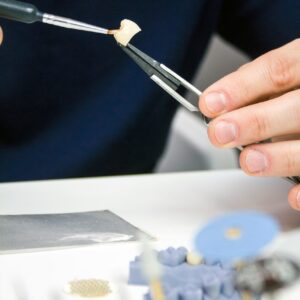WHAT THEY ARE AND HOW THEY WORK
Dental crowns are custom-made caps that cover a damaged, decayed, or weakened tooth to restore its shape, strength, and appearance. Crowns are often used when a tooth is too compromised for a filling but not so damaged that it must be removed. They effectively “crown” the visible portion of the tooth above the gum line, reinforcing its structure and improving function.Crowns are commonly used after root canal therapy, to support a large filling, or to cap a cracked or worn-down tooth. They are also placed over dental implants or used to anchor dental bridges. Without proper reinforcement, compromised teeth can continue to break down, affecting your bite, jaw function, and overall oral health. Depending on your needs, crowns can be made from several materials including metal alloys, porcelain fused to metal, all-ceramic, or all-resin. For front-facing teeth, all-ceramic or porcelain crowns offer the most natural appearance, blending seamlessly with your existing smile. Crowns are designed to last many years with proper care, restoring both aesthetics and strength to your teeth.


Initial Evaluation & Treatment Planning
-
The dentist performs a full exam, including X-rays, to assess the health of the tooth and surrounding structures.
-
Treatment options are discussed, and a crown is confirmed as the most suitable solution for restoring the tooth.
-
The material for the crown—such as porcelain, metal, or zirconia—is selected based on function and aesthetics.

Tooth Prep & Temporary Crown
-
The affected tooth is reshaped by removing a portion of enamel to make room for the crown.
-
Impressions or digital scans are taken to ensure a precise fit for the permanent crown.
-
A temporary crown is placed to protect the prepared tooth while the permanent crown is being fabricated.

Crown Fabrication
-
The dental lab uses the impressions or scans to create a custom crown that matches the shape and shade of your natural teeth.
-
Crowns may be made from ceramic, porcelain-fused-to-metal, all-metal, or zirconia, depending on your needs.
-
Fabrication typically takes 1–2 weeks to ensure proper function and aesthetics.

Final Placement & Adjustment
-
The temporary crown is removed, and the permanent crown is placed to check fit, bite, and appearance.
-
Minor adjustments are made to ensure the crown feels natural and functions comfortably.
-
Once everything is ideal, the crown is cemented in place and you’re given care instructions to maintain it.
What to expect during treatment
During dental crown treatment, you can expect a two-step process. At your first visit, the dentist will evaluate the tooth, reshape it to make room for the crown, and take impressions or digital scans. A temporary crown is placed to protect the prepared tooth while your permanent crown is crafted in a dental lab. You may experience minor sensitivity or discomfort, but it’s generally short-lived. At the second visit, your custom crown is carefully fitted, adjusted for comfort and bite, and permanently cemented. Your dentist will provide care instructions to help ensure your crown looks and functions like a natural tooth for years to come.
How to care for your dental crown
Proper care for your dental crown ensures it lasts and protects your natural tooth. Brush twice daily with a soft-bristle toothbrush and fluoride toothpaste to keep the crown and surrounding gum tissue clean. Floss gently around the crown to prevent plaque buildup at the gum line. Avoid chewing hard objects like ice or pens, and steer clear of sticky or crunchy foods that could dislodge or crack the crown. Schedule regular dental visits for cleanings and exams to monitor the crown’s fit and the health of the underlying tooth. With consistent care, your crown can last many years and function just like a natural tooth.

